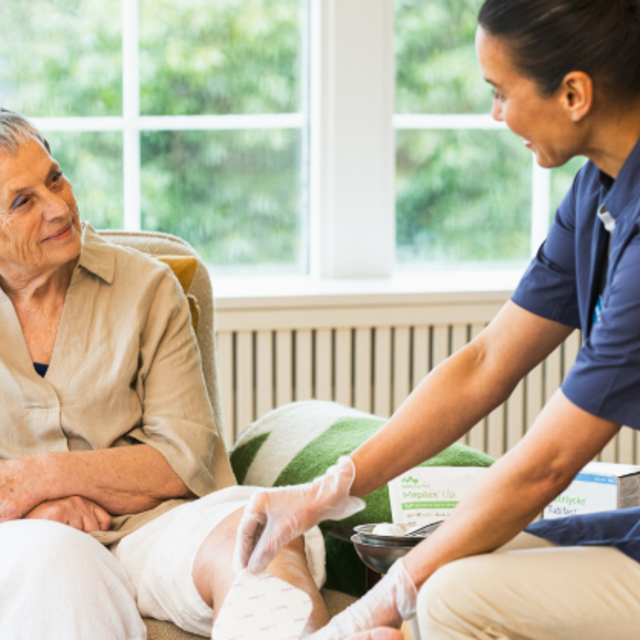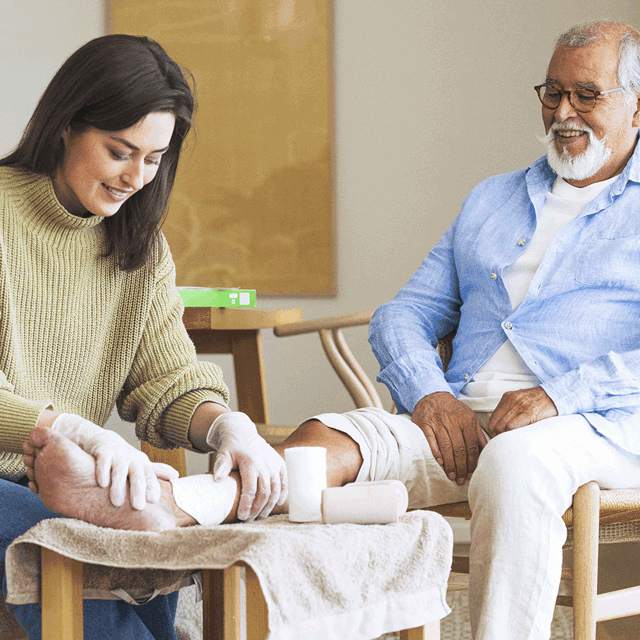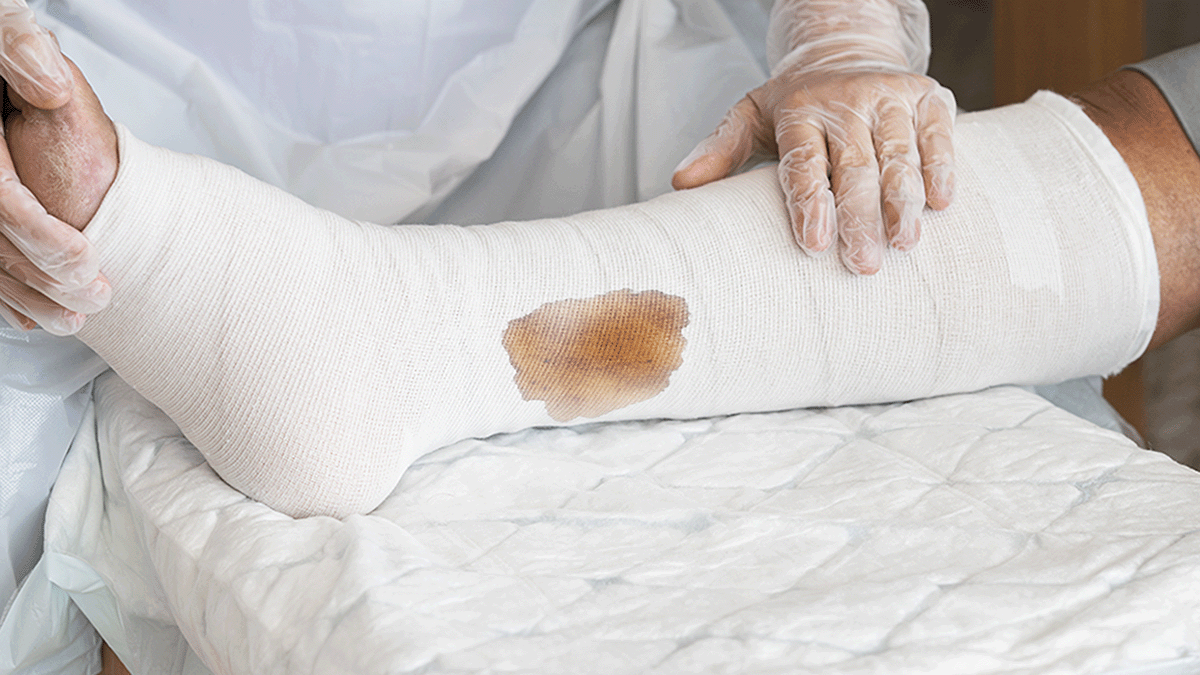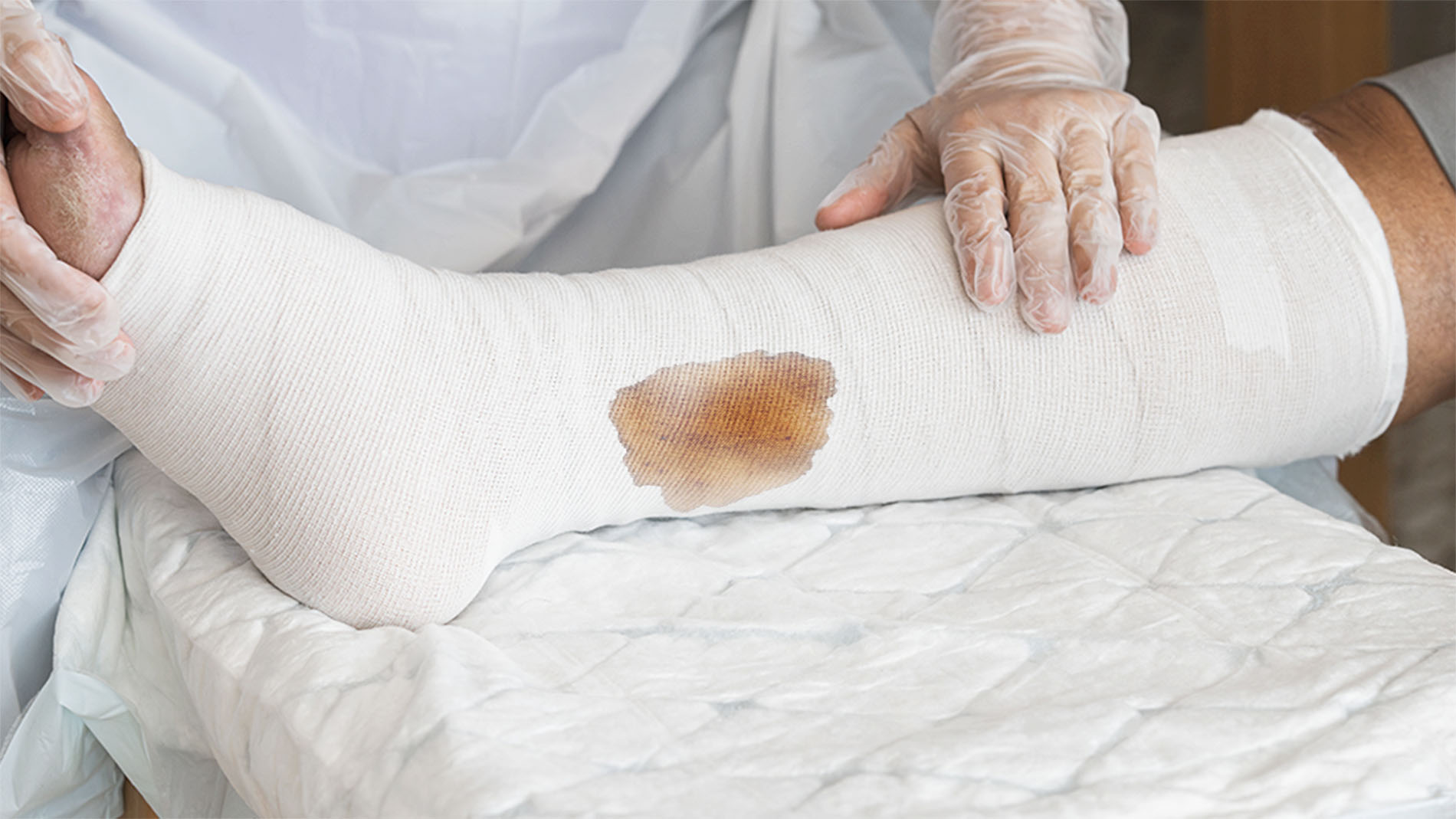For complex VLU
Learn more about wound care
We know how hard it can be to fit continuous learning and development into a nurse’s already busy schedule. That’s why we designed a comprehensive series of digital learning modules that you can use on demand at a time and place that suits you. In many markets, we also offer onsite training and workshops. Reach out to your representative to learn what is available for you.
Build your learning pathway
The Clinical Learning Hub is the home of educational needs for all levels of healthcare professionals and providers.
Start learning today-
Webinar
Discover webinars packed with valuable information about VLU care. Increase your expertise and enhance your professional development with these informative sessions.
Attend now -
Podcast
Tune into a wealth of podcasts, including several sharing valuable knowledge about VLU care. These insightful episodes will give you a headstart on your professional journey.
Listen now

How to treat venous leg ulcers
Venous leg ulcers (VLUs) are a common yet challenging condition that requires a holistic approach to treatment. Effective care involves cleansing, debridement, exudate management, and compression therapy—all essential steps in promoting healing and preventing recurrence. By choosing the right solutions, healthcare professionals can support patients in achieving better outcomes and improved quality of life.

Wound Care For All
Provides resources to support nurses, patients, family members and non-medical care givers to confidently manage hard-to-heal wounds at home or in any non-hospital setting.
-

Wound care | 5 min read Venous leg ulcers: Clinical understanding and epidemiology
The underlying cause of a venous leg ulcer (VLU) is venous disease. Not everyone with vein problems will go on to have a leg ulcer, but everyone with a venous leg ulcer will have signs and symptoms of venous disease that they can trace back over time.2 Epidemiology Venous leg ulcers are a common, chronic, recurring condition, with an estimated prevalence of between 0.1% and 0.3% in the UK.3 Up to 10% of the population in Europe and North America has venous valvular incompetence, with 0.2% developing venous ulceration.4 In the UK, population prevalence rates for VLUs range from an estimated 1 in every 100 adults, or an approximate annual number of 560,000 individuals with a VLU at any given time.5 As the population ages, all these factors will escalate the cost to the patient and healthcare organisations. Aetiology Venous leg ulcers occur due to chronic venous insufficiency (CVI). This happens when the valves of the veins (deep or/and superficial or/and perforator veins) do not function correctly and allow the blood to flow back down (reflux) into the section of vein below. The pathology can also include venous obstruction (e.g., from blood clotting).6 Venous drainage is impaired, which will lead to venous hypertension.7, 8 Between 40–50% of venous leg ulcers are due to superficial venous insufficiency combined with perforating vein incompetence, but the deep vein system4 is usually normal. Diagnosis of chronic venous insufficiency is based on clinical characteristics; chronic venous hypertension causes a number of skin changes: oedema visible capillaries around the ankle trophic skin changes such as hyperpigmentation caused by hemosiderin deposit atrophie blanche induration of the skin and underlying tissue (lipodermatosclerosis) and stasis eczema9 In patients with chronic venous insufficiency, the inability of the calf muscles to pump venous blood contributes to the development and delayed healing of venous ulcers. As a result, compression treatment is used to treat lower limb venous insufficiency.5, 10 There are many risk factors for venous ulceration, including heredity, obesity, venous occlusion, and age.4, 10 Importantly, venous leg ulceration reoccurs in up to 70% of people who are at risk.4 More than 95% of venous leg ulceration is in the leg below the knee, usually around the malleoli, and ulceration may be discrete or circumferential.11 Clinical and economic burden In the UK, as an example, venous leg ulcers have been estimated to cost the National Health Service £941m ($1.2b; €1.1b) per year.12, 13 Most of this healthcare cost is due to community nursing services, as district nurses in the UK spend up to 80% their time caring for patients with leg ulcers.12, 13 Physicians need to be aware that venous leg ulcers have an improved chance of healing if patients can be admitted to hospital for continuous leg elevation.14 Too often, early preventive treatment is not undertaken due to the increasing number of patients with venous leg ulcers and the increasing shortage of hospital beds, the high cost of in-patient hospital care, and the need to maintain independence in the mainly elderly population who suffer from venous leg ulcers.14 Effects on patient quality of life Venous leg ulceration is often a chronic condition, and patients experience a prolonged cycle of skin healing and then breakdown (read more about the challenges of this cycle). This cycle of wound healing and reversal sometimes repeats over decades, with episodes of infection, all of which can impair quality of life.15 Optimal management and care of venous leg ulcers: Psychosocial and pain responses Management of leg ulcers occurs mainly in the community, but community nurses and general practitioners have limited time to spend with patients, and this time is usually directed to clinical management15. Psychological and social effects of venous leg ulceration have received little attention in clinical management guidelines but include social isolation, anxiety, and depression, particularly when ulcers are highly exudative and painful.15 In a recent exploratory study undertaken to compare the pain and stress experiences of 49 patients with chronic wounds being treated with atraumatic vs, conventional dressings during dressing change, acute episodes of pain and stress were much lower in patients receiving atraumatic dressings. Optimal management and care of venous leg ulcers: Dressing selection and M.O.I.S.T. model As with most wound types, venous leg ulcers benefit from appropriate dressing selection and implementing a M.O.I.S.T. healing model. Selecting dressings and M.O.I.S.T. management complement each other. Topical wound therapy options, such as dressings, are selected based on the goals and actions for healing, such as creating a balanced moist healing environment or improving tissue oxygenation, which are two of the key properties of the M.O.I.S.T. model. The M.O.I.S.T. model is an acronym that stands for: Moisture balance: Creating a balanced moist healing environment Oxygen balance: Improving tissue perfusion and local oxygenation at the wound bed Infection control: Avoiding wound infection or treating an existing infection Supporting strategies: Creating a supportive wound environment to stimulate healing Tissue management: Removing devitalised tissue and debris, to form healthy granulation and epithelial tissue M.O.I.S.T. principles can be applied across a range of chronic wounds, including VLUs, and the application of M.O.I.S.T. has been shown to help such wounds “progress toward healing or achieved complete healing”.16
-

Wound care | 5 min read The impact of venous leg ulcers and “leaky legs”
One particular symptom is excessive wound fluid leakage, sometimes informally described as “leaky legs” or “wet legs”2 when patients explain their symptoms. But wound fluid leakage is a symptom of an underlying problem – and it should not be accepted as the norm. Hard-to-heal wounds like VLUs impact patients in many different ways. These wounds often go improperly diagnosed and thus fail to heal, which leads to continuous production of a high volume of wound exudate. Both the wound and the presence of exudate signficantly and negatively impact such patients’ quality of life3. The possibility for leakage, soiling clothes and bedding, malodour, and other embarrassing challenges make VLUs – undiagnosed or not – physically problematic as well as psychologically traumatic. Dismissing ongoing excessive exudate as “normal” and treating “leaky legs” (and this expression) as a diagnosis is problematic and does a disservice to patient health and quality of life2. Wound fluid leakage: A symptom, not a diagnosis Wound leakage and exudate management is one of the most challenging side effects of VLUs. Yet, with a progressively healing VLU, exudate levels should become more manageable with time. However, if a patient has been left without a diagnosis, which would help guide treatment for venous disease, the problem of “leaky legs” may become normalised without further investigation. Patients frequently report leakage as a symptom, and unfortunately, rather than getting to the root cause of the excessive exudate, heavily exudative wounds are treated without further diagnosis. Instead, the copious amount of exudate should act as a clue for understanding a deeper cause, which is likely venous disease but may also be affected by comorbidities that affect healing. For healthcare professionals, it is critical to support healing by going beyond the surface to do two things: one, perform robust wound assessment, taking the whole person/patient into account, and two, understand venous disease and how it is linked to ulceration. Striking the exudate balance When treating venous leg ulcers, a moist wound environment is important, which means that a certain amount of exudate with the right composition plays a crucial role in wound healing. The type and volume of exudate tells a story about the wound and can indicate its potential to heal7. Understanding what makes exudate healthy and unhealthy is an important part of treatment. Healthy exudate is straw-coloured and should decrease in volume as wound healing progresses. Wounds that are slower to heal present with too much or abnormal exudate, and are likely signs that underlying venous disease is present2 and requires diagnosis and treatment beyond just trying to take care of or mask excess exudate. Typical treatment for supporting healing includes appropriate compression therapy (if not contraindicated) and infection management (if present)2. Quality of life issues due to leg ulceration Nevertheless, the presence of excess exudate, while indicative of a more systemic problem, is by itself negative for VLU patients. Not only do these patients have to worry about the possibility of more frequent – and potentially traumatic – dressing changes to manage the overabundance of exudate and the associated pain and skin maceration, odours, damage to clothing and bedding, but they also experience psychological issues, ranging from social isolation and depression to self-esteem problems4, 5, 6. In addition, there is also a possibility of a negative socioeconomic impact on their lives, as they stop going to work or lose their jobs8. In addition to these quality-of-life issues, the lack of improvement in the wound and exudate can lead to worse problems. First, patients sometimes take matters into their own hands, using inappropriate products to contain wound leakage, which may lead to more serious complications. And second, increased pain from periwound skin damage and an increase in infection incidence create greater discomfort, further delayed healing, and sometimes in patients being prescribed multiple courses of systemic antibiotics because the root cause of the local infection is not addressed9. Without healing and a proper diagnosis and course of treatment, patients will require increased clinical interventions2, which further impacts patients’ quality of life and burdens healthcare systems. Treating the underlying cause of leaky legs Appropriate assessment of exudative wounds and abnormal exudate as well as a complete assessment of the patient as a whole is needed to ensure that a proper diagnosis is achieved. Until the root cause is identified, the excess leakage problem will persist and the wound may go unhealed, creating a negative impact on patient health and quality of life indefinitely. The patient is entitled to a proper diagnosis and treatment that gives their wound the best chance to heal.
-

Wound care | 2 min read Wound exudate: how to assess and manage exuding wounds for the best patient outcomes
Managing exudate in chronic wounds: how much do you know? Too much exudate may saturate the wound and could damage the surrounding skin, increasing the risk of complications and preventing or slowing healing. But too little exudate can mean a dry wound that may also be slow to heal. A moist wound bed and a dry periwound area are generally considered best for promoting healing. By understanding exudate and managing it correctly you can promote timely healing and reduce the risk of complications for your patients. For chronic wounds, such as Venous leg ulcers (VLUs) or Diabetes related foot ulcers (DFU), where ongoing assessments are needed, monitoring and managing exudate is an important aspect of wound care. Excess exudate, which can cause leakage and odour, can be distressing for patients and may result in a slow-to-heal or non-healing wound. This can be extremely disheartening, both for patients and the healthcare professionals they rely on. Dressing choice plays a key role in the effective management of exudate in chronic wounds combined with therapies such as debridement, compression and Negative pressure wound therapy (NPWT), depending on the type of wound. You can learn more about exudate, including how to assess it, the ideal dressing for exudate management and the role of various wound therapies, in Exudate: Effective Assessment and management. This is a consensus document from the World Union of Healing Societies (WUWHS) 2019, supported by an education grant from Mölnlycke among others.


